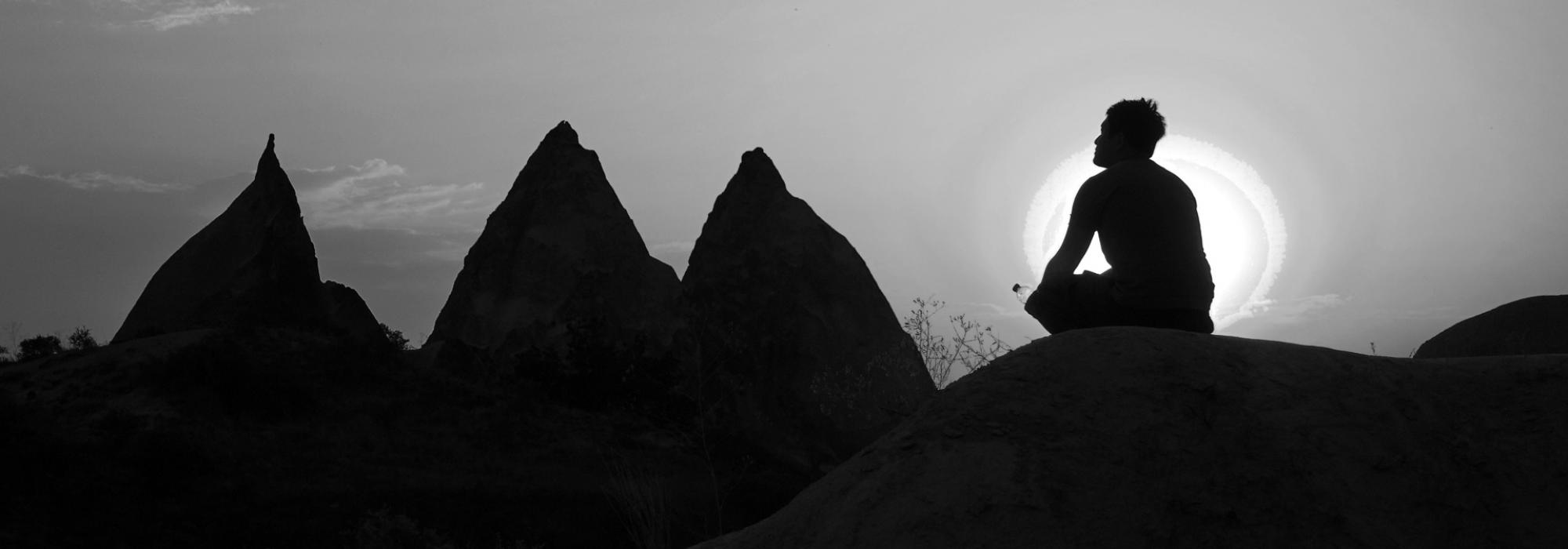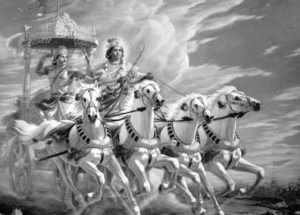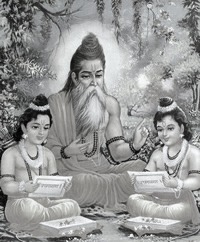For a moment, just visualize the kind of public debates that happen today – on television, in the newspapers, and in person. In the light of these images floating in your mind, read the following lines:
Why fear them? Why pay attention?
Why listen to your opponent’s words?
Just contradict them immediately.
You are sure of victory in the debate!
The five rules for victory are:
be cool, be shameless, be mocking,
despise your opponent, and
praise those in power.
If the mediator is not learned,
shout your way to victory.
If the mediator is learned,
simply accuse him of being biased!
Don’t these words perfectly align to the images in your mind? Just that these lines are taken from Nilakanta Dikshita’s satire Kali Vidambana, ‘mockery of the kali yuga,’ written sometime in the 17th century. And it is perhaps significant that he begins his composition with the above lines, poking fun at the intellectuals of his time.
A common feature in public discussions and debates of today is that people are more interested in forcing their view than embarking on a joint quest to know the truth. The debaters seem to have an opinion about everything. In fact, they are offended if one doesn’t have an opinion on something. Further, there seems to be little or no accountability in standing by what they have said.
In ancient India, there has been much discussion about freedom of expression and public discourse. This starts with understanding what constitutes eloquent expression. One of the earliest discussions on this subject is found in the story of Sulabha in the Mahabharata (Shantiparva / Book 12, Chapter 308). Sulabha, a wandering woman mendicant, debates with Janaka, the philosopher-king, who has become over-confident and pompous due to his spiritual achievements. While Janaka stoops to character assassination and vulgar speech, Sulabha patiently and methodically demolishes his arguments. The Mahabharata doesn’t tell us who won the debate but clearly Sulabha’s words stand out as opposed to the deluded Janaka.
In the course of their discussion, Sulabha mentions (MB 12.308.79) that in an assembly of intellectuals, the statements made by the debaters should reflect the following five qualities:
- सौक्ष्म्य (saukshmya) – subtlety, finesse
- साङ्ख्य (sankhya) – listing out the points
- क्रम (krama) – order, logical flow of arguments
- निर्णय (nirnaya) – decisiveness
- प्रयोजन (prayojana) – being clear about the purpose of debate or discussion
Later on, she mentions the various imperfections in discourse. (MB 12.308.88-90) They may be divided into flaws of expression and flaws of intent.
Flaws of expression
- गुर्वक्षरसंबद्धम् – verbose
- पराङ्मुखमुखम् – complex
- अनृतम् – untrue
- त्रिवर्गेण विरुद्धम् – opposed to the three basic purposes of human life: dharma (principles), artha (resources), and kama (enjoyment)
- असंसकृतम् – uncultured, ungrammatical
- न्यूनम् – deficient, too brief
- कष्टशब्दम् – strained usages, forced language
- व्युत्क्रमाभिहितं – arrogant tone
- शेषम् – incomplete
- अकल्पेन – ambiguous
- निष्कारणम् अहेतुकम् – without reason, baseless
Flaws of intent
While making a statement, one should not be affected by the following emotions –
- काम (lust)
- क्रोध (anger)
- भय (fear)
- लोभ (greed)
- दैन्य (self-pity)
- अनार्यत्व (disgrace)
- ह्री (shame)
- अनुक्रोश (pity)
- मान (arrogance)
Sulabha then makes a wonderful observation – “During the course of a discussion, when the speaker, the listener, and the words spoken agree with one another without conflict, then the meaning comes out clearly.” (MB 12.308.91)
In the Bhagavad-Gita, Krishna gives a holistic view of right expression by saying, “Speaking words that are truthful, pleasant, beneficial, and not causing distress or anxiety, as well as the study and recitation of scriptures – this is austerity of speech.” (BG 17.15)
The great law-giver and seer Manu goes on to say that one must speak words that are both truthful and gentle – neither gentle words that are false nor harsh words that are true. (Manusmrti 4.138)
The great poet Bharavi says in his magnum opus (Kiratarjuniya 11.38) that speech should, in essence, evoke serenity, cheerfulness, and positive energy.
Basically, the people of ancient India believed that Truth was sacred. So the Word was to be used to utter the truth and to take us closer to the truth. Intellectual integrity was of the highest importance.
In our quest from ignorance to the truth, we start out with bias. Each of us has our biases and stereotypes; these are often based on flimsy evidence. The next stage of refinement is opinion. Having thought about the subject at hand, we come up with our views and impressions; this doesn’t require deep study, only cursory analysis and logic. Further refinement leads to perspective. When we examine the available facts and look at the different sides of the argument, we take an informed stance on the subject; after much toiling we construct our worldview. The final stage before we reach the truth is vision. Not only do we examine all the facts from the different sides but also internalise the various ideas, thus developing a holistic vision. We become clear about what our assumptions are, what the facts are, what constitute our analyses, and finally, what the purpose of the study is. It is interesting to note the importance that Kautilya gives to आन्वीक्षिकी (anvikshiki), ‘reasoning’ in the Arthashastra (1.2).
A useful framework to have while embarking on a discussion is found in the अनुबन्ध चतुष्टय (anubandha catushtaya), ‘the four bindings’ that Sadananda Yogendra Sarasvati puts forth (Vedantasara 1.5) for the study of Vedanta, which can be easily applied to discussions in general:
- अधिकारि (adhikari) – one who is qualified to study or speak about a subject
- विषय (vishaya) – the subject matter; the scope of the discussion
- सम्बन्ध (sambandha) – the connection of the adhikari to the vishaya
- प्रयोजन (prayojana) – the purpose of the discussion
Some of the biggest gaffes in today’s debates are because one or more of these four criteria aren’t taken into consideration.
Perhaps the most systematic exposition on the subject of discussions and debates is found in the Nyaya school, one of the six classical schools of Indian philosophy. The sage and philosopher Akshapada Gautama wrote the Nyaya Sutra, which is the earliest text of this school. He starts off (Nyaya Sutra 1.1.1) with listing out the sixteen padarthas, ‘categories’ that leads to success in attaining knowledge and goes on to explain them in the succeeding verses (NS 1.1.2-41, 1.2.1-20) –
- प्रमाण (pramana) – refers to the methods by which knowledge is obtained; there are four: pratyaksha (by direct perception; seeing), anumana (inference; assumption), upamana (comparison; relying on what is already known), and shabda (scriptures; reliable sources)
- प्रमेय (prameya) – refers to the subject of study; traditionally it was soul, body, mind, etc.
- संशय (samshaya) – refers to the doubt that arises from conflicting judgment about the exact nature of something
- प्रयोजन (prayojana) – refers to the purpose of the study; what one aims to achieve and/or avoid
- दृष्टान्त (drishtanta) – refers to the points of agreement; these are commonly held views that are at once acceptable to the scholar and lay man
- सिद्धान्त (siddhanta) – refers to an established theory that derives its authority from a particular school of thought or hypothesis
- अवयव (avayava) – refers to the elements of reasoning; there are six: pratijna (proposition), hetu (reason), udaharana (example), upanaya (application, reaffirmation), and nigamana (conclusion)
- तर्क (tarka) – refers to the act of reasoning that is carried out in order to know the exact nature of something
- निर्णय (nirnaya) – refers to the decision taken after listening to the opposing sides, thus removing the doubts and getting closer to the truth
- वाद (vada) – refers to discussion carried out with the intention of getting closer to the truth; in this case, there is no need for a mediator because those involved in the discussion are jointly seeking the truth and do not intend to debate with one another
- जल्प (jalpa) – refers to debate (or argument) that is carried out with the sole intention of winning and proving one’s point; in this case, a mediator is required and the ground rules have to be laid clearly
- वितण्डा (vitanda) – refers to malicious quarrel that is employed with the sole intention of maligning the opponents and contradicting their views without any grounds; this used to be punishable by law
- हेत्वाभास (hetvabhasa) – refers to the fallacies in reasoning; in this case, the arguments are hollow, erratic, ill-timed, and contradictory
- छल (chala) – refers to deceit in argument; here, the debater could intentionally misinterpret an ambiguous word used by his opponent or by taking the literal meaning of a metaphor used by the opponent
- जाति (jati) – refers to futile refutation of arguments and making claims that are self-contradictory
- निग्रहस्थान (nigrahasthana) – refers to the points of defeat; there are several instances where the debater might be checkmated or trapped
Manusmrti 12.102-19 deals with law-making and setting up of the sabha (assembly). There are many details that go into the setting up of a sabha and it is important to get the opinions of the sabha before presenting your views on a public platform. In the early days, it was not so easy to share one’s ideas with the world without getting it whetted by a group of learned people.
In his comment on MS 12.113, Kulluka Bhatta says that it’s no use blindly following the letter of the law; if we don’t ponder upon the matter with our common sense, then dharma may be violated (we find a similar idea in Brihaspatismrti 1.1.19). This is particularly instructive in grey areas where no specific rule can be invoked (for example, what counts as being obscene in a movie?)
Kautilya’s Arthashastra (3.18) prescribes specific monetary fines for mithyaropa (false accusations) and vakparushya (abusive language). Further, Kautilya says that slander is bad but abuse of money and property is worse (A 8.3). Basically, if we think bad thoughts, nobody can punish that; if we speak bad speech, then that is punishable in small measure; and if we do bad deeds, then that is punishable in larger measure.
Manusmrti 8.13-15 speaks about the practical aspects of dharma in daily life. Manu says, “Either you stay out of court, or having entered, speak the truth. If you remain silent or if you tell a lie, you are a sinner.” Manu also says that each one should follow his duty as per his profession (MS 8.42). These verses underscore the idea that the onus to maintain integrity is not only on the judges and law-makers but also on the individuals of a society. Fines and punishments can work only to a certain extent.
There is also much discussion in today’s world about what kind of art is acceptable and what is objectionable. In these matters, one has to simply follow the laws of the land. It is almost impossible to have a detailed framework and set of rules for every possible type of transgression. In general, we can say that if we want to judge any art, we have to use the principles of aesthetics.
In the Natyashastra (1.7-15), Bharata speaks about the origin of drama. He says that since audio-visual entertainment was lacking and people were indulging too much in sensual pleasures, he created drama as a positive distraction. After drama was created, there began a preparation for conducting the first ever drama, ‘the churning of the ocean.’ When it was staged, the demons were upset that the play showed them in a bad light. They created a huge ruckus, jumped on stage, manhandled the actors, and disrupted the play. Indra and other gods fought with them and defeated them. Then they went to Brahma and complained about their plight. He pacified them saying that it’s just a play and sometimes the gods might win while at other times, the demons might win. He asked them not to take it personally (N 1.101-7). This clearly suggests that one should not read too much motive into the art. Ultimately, art should bring joy and serenity (N 1.114-15). In fact, Dhananjaya goes as far as saying that only fools look for education in art instead of enjoyment (Dasharupaka 1.6). Even if we are dealing with propagandist art, there is little that we can say outside of the aesthetic principles of the art itself. And if we are really upset by it, we can always compose a parody in response.
In the final chapter of the Natyashastra (36.33-35), there is an episode where Bharata’s sons get conceited with their knowledge of drama and produce a cheap play that caricatured prominent seers and saints. The sages, upset by this, curse the sons of Bharata. The Gods intervene on their behalf and reduce the effect of the curse such that drama is saved, although the artistes remained cursed. This instructive episode suggests that in the name of artistic freedom, it is unwise to caricature people who are worthy of respect. Further, it is always the art that should be protected even if it is at the cost of a few artistes.
Finally, in order to understand public discourse better, let us look at a few examples of beautiful debates and discussions in our traditional texts. In Brihadaranyaka Upanishad 2.1.1-20, Dripta-Balaki, a brahmana, goes to King Ajatashatru and starts boasting about his knowledge of brahman (Supreme Being). The king patiently hears him out and finally says that his knowledge is incomplete. There is more to be known. Then the brāhmaṇa, realizing his folly, asks the king to guide him. Ajatashatru remarks that it was strange indeed that a brahmana was learning about brahman from a kshatriya but goes on to explain the subject since Balaki sought instruction.
In Chandogya Upanishad 5.3.1-7, young Shvetaketu goes to his father Uddalaka and tells him about the questions posed by King Pravahana. Shvetaketu accuses his father of not teaching him everything that he knew. Uddalaka is surprised at hearing the questions and tells his son that he himself doesn’t know the answers. Then they both go to the king to learn that from him. Pravahana tells Uddalaka that previously the knowledge was only with kshatriyas but he would go forth and instruct the brahmanas who seek the knowledge.
A later chapter of the Chandogya Upanishad (6.1.1-7) narrates the story of Shvetaketu going to study the Vedas for twelve years and returning to his father’s house as a young man who is quite conceited with his learning. His father Uddalaka tells him that he has become complacent and arrogant, so much so that he doesn’t know the ultimate teaching. Shvetaketu asks, “How can there be such a teaching?” Now, Uddalaka doesn’t ridicule him or rebuke him. He gently takes Shvetaketu on the right path by means of explaining the ultimate teaching.
In Brihadaranyaka Upanishad 3.7.1, Uddalaka Aruni warns Yajnavalkya that his head would fall off if he did not know what he claimed to know. It is a beautiful metaphor that reminds us to be accountable for what we say, to the extent that we would give our life if what we said was untrue.
In Brihadaranyaka Upanishad 4.1-4, King Janaka and Sage Yajnavalkya hold a discussion on a variety of topics. That is a classic example for vada – a discussion between equals and at the highest level. Neither judge nor arbiter nor audience is required. There is neither clamour nor polemics but just a joint effort in the quest of truth.
There is a lovely dialogue between the Buddha and Malunkyaputta in the Chulamalunkya Sutta from the Sutta Pitaka. Malunkyaputta poses many unanswerable questions to the Buddha (“Is the cosmos finite?”, “Is the cosmos eternal?”, etc.) In response, the Buddha tells him the story of a man who has been fatally wounded with a poisoned arrow. The wounded man’s friends and relatives are willing to bring a surgeon to pull out the arrow but the man first wanted to know the caste of the man who shot the arrow. Then he wanted to know the name and clan of the man. Then he wanted to know the physical characteristics of the man. Then he wanted to know where the man came from and what kind of bow he used. And so on. The Buddha tells Malunkyaputta that before all these questions were answered, the man would die. So first, focus on what is pertinent and then you may think about the rest of the universe.
Co-written by Hari Ravikumar.
References
Ganesh, Shatavadhani R. ಷಡ್ದರ್ಶನ ಸಂಗ್ರಹ. Bangalore: Bharatiya Vidya Bhavan, 1997. pp. 17-34
Ghosh, Manomohan. The Nāṭyaśāstra. Vols. 1-2. Calcutta: The Royal Asiatic Society of Bengal, 1950
Kirātārjunīya <http://gretil.sub.uni-goettingen.de/gretil/1_sanskr/5_poetry/2_kavya/bhakirxu.htm>
Mahābhārata <http://sacred-texts.com/hin/mbs/mbs12308.htm>
Manusmṛti <http://www.hinduonline.co/vedicreserve/smriti/14Manu_Smriti.pdf>
Nyāya Sūtra <http://hinduonline.co/vedicreserve/darshanas/nyaya.pdf>
Pandey, Bajinath. Śrīdhanañjayaviracitam Daśarūpakam. Varanasi: Motilal banarsidass, 1971. pp. 7
Radhakrishna, S. The Principal Upaniṣads. London: George Allen & Unwin, 1953
Shamasastry, R. Kautilya’s Arthashastra. New Delhi: Chaukhamba Sanskrit Pratishthan, 2007
Sreekrishna, Koti and Ravikumar, Hari. The Complete Bhagavad-Gita. Mason: W.I.S.E. Words Inc., 2014. pp. 674
Thanissaro Bhikkhu. Cūḷamāluṅkya Sutta (1998) <http://www.accesstoinsight.org/tipitaka/mn/mn.063.than.html>
Tripathi, Radhavallabh. Vāda in Theory and Practice. New Delhi: D. K. Print World, 2016
Vasudeva, Somadeva. Three Satires: Nīlakaṇṭha, Kṣemendra, and Bhallaṭa. New York: New York University Press / JJC Foundation, 2005. pp. 320-21
Vidyabhushana, Satisa Chandra. The Nyaya Sutras of Gotama. Allahabad: The Panini Office, 1913. pp. 1-21






































Comments